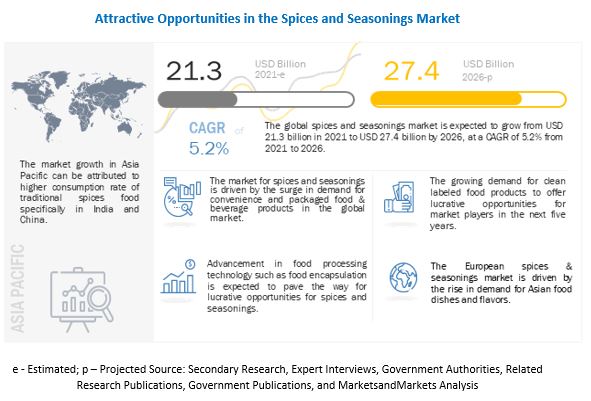
The global spices and seasonings market is expected to grow from USD 21.3 billion in 2021 to USD 27.4 billion by 2026, at a CAGR of 5.2% from 2021 to 2026. Spices are plant extracts that are added to food items for enhancing their color, aroma, flavor, taste, and shelf-life. These are available in whole, ground, or blend form. Among the various types of spices and seasonings considered in this study, pepper accounted for the largest share in the global market. Capsicum is projected to grow at the highest CAGR during the forecast period. However, prices for spices and seasonings vary from region to region. The prices are comparatively high for import-dependent regions such as Europe and North America. These regions account for a lower production share in the global market. As a result, such regions incur logistics and maintenance expenses while procuring spices from exporting countries. On the other hand, India and China are the key producers and exporters of spices incurring lower price rates. Hence, the variation of prices of spices hampers the overall growth rate of the spices and seasonings market, specifically for import-dependent countries such as the US, the UK, and Canada.
North America and Europe import a majority of spices from developing countries in Asia Pacific, which include India and China. There have been increasing incidences of adulteration of spices exported from these developing countries. Due to these incidences of adulteration and contamination, stringent regulations by the US FDA and the European Spice Association have been laid down for imported spices from Asian countries. Suppliers have to provide microbial contamination test certificates and also fulfill the requirements mentioned in the regulations.
Download PDF brochure: https://www.marketsandmarkets.com/pdfdownloadNew.asp?id=739
The ginger segment hold the largest share in the spices and seasonings market followed by capsicum which is the second largest segment. Available in different colors, capsicum is used across the world in many different types of dishes. The vegetable, also known as bell pepper, originated in tropical America and has been used as a medicine because of its medicinal properties. It is low in fat and is associated with remedies for many diseases. The vegetable is one of the best sources of carotenoids such as beta-cryptoxanthin, zeaxanthin, and lutein. It is also rich in vitamins, minerals, and other nutrients. Hence, capsicum has become a significant part of the human diet in many parts of the world. Fruits are consumed in fresh, cooked, or processed forms. Fresh peppers are often used in salads. Fruit is also processed into various fermented products, powders, sauces, curry pastes, and salsas. Chilies are also sold as frozen, canned, dried (whole or crushed pieces), and pickled fruit. Dried chilies are often ground into powders and added into various culinary preparations and other dishes. Fresh or dried chilies are also used to make hot sauce. Chili in the form of powder or paste is a vital ingredient of Indian curries.
primarily for economic gain. The regulatory standards ensure that the product does not contain ingredients that do not meet legislative or safety standards. Adulteration is often the intentional addition of an unauthorized or degraded ingredient or item to increase the spice’s value or to make it cheaper to produce. It is one of the major concerns for the spice industry.
Recently, there have been numerous recalls of dried spices due to chemical contamination. These include the presence of unauthorized colors/dyes and heavy metals. Instances of above-average levels of metals such as cadmium and pesticide residues were found in many spices which were recalled. The increasing incidences of spice adulteration have become a major restraint for the market.
